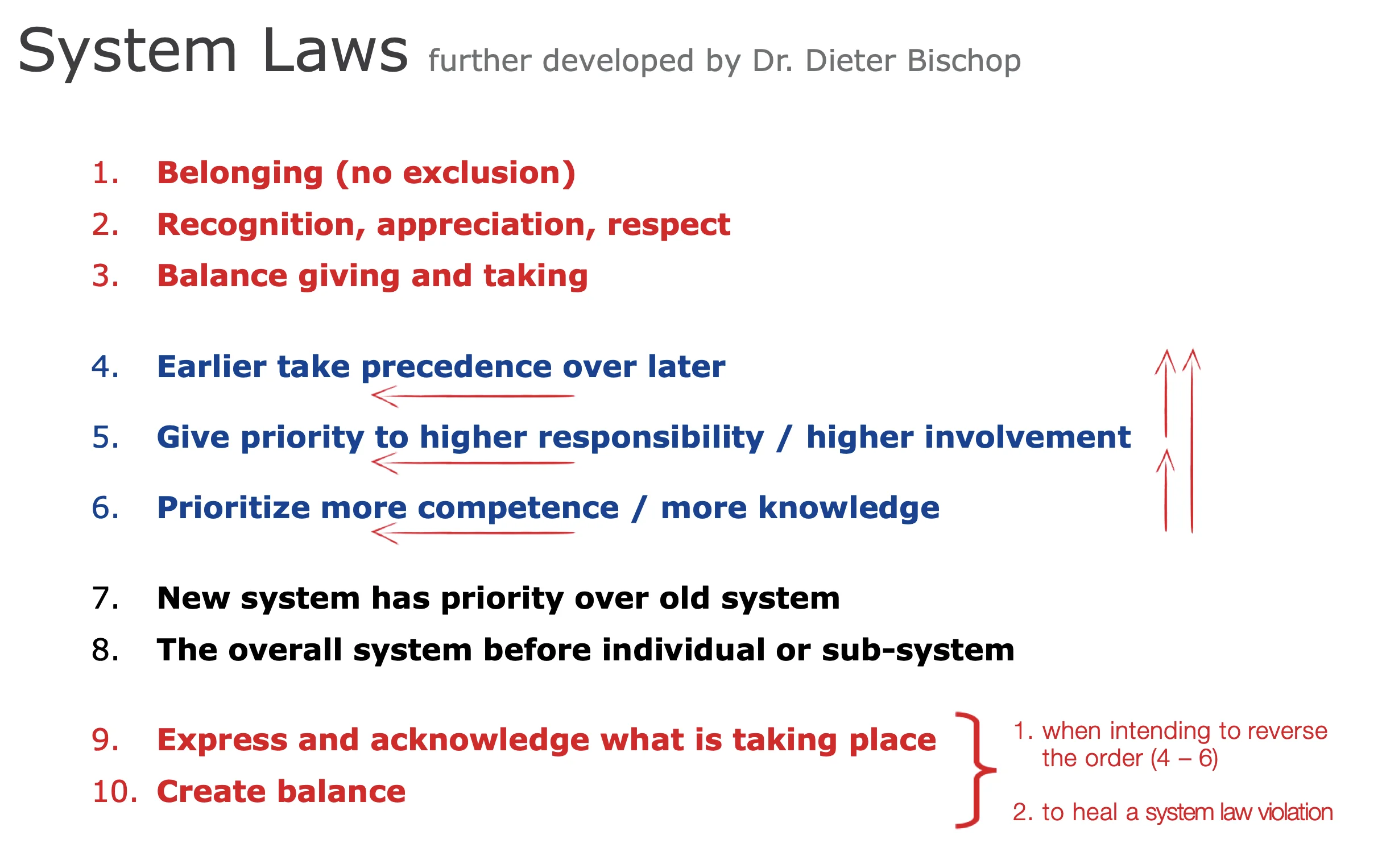Understanding System Laws: The Root of Conflicts and How to Resolve Them
At the heart of systemic thinking lies the concept of a system, which is essentially a dynamic interplay between two or more participants. These system laws provide the blueprint for ensuring open, constructive communication, free of conflicts.
If system laws aren’t respected, it can stir up conflicts. This often results in misunderstandings and disagreements. If these issues aren’t effectively tackled, they can escalate to the point of total communication breakdown, which can jeopardize the entire system.
Take this as an example:
A couple wants to have a movie night together. One partner picks out a romantic movie, while the other is keen on watching live sports. They can’t come to an agreement because neither wants to compromise on their choice.
The man is aware that his partner doesn’t enjoy watching live sports, just as she knows he’s not a fan of romance movies. But since neither recognizes nor appreciates the other’s preferences, an argument ensues. The situation deteriorates to the point where the disagreement becomes heated. In the end, they each retreat to separate TVs and watch their chosen shows alone.
The Law of Mutual Recognition, Appreciation, and Respect is just one of the 10 system laws that shouldn’t be broken. In this article, you will be introduced to all of the system laws, so you can grasp how these laws effect all of our “day to day” lives. If some of these system laws are breached, you can pinpoint the root cause of conflicts and work towards a resolution.
Why are System Laws Vital for Both Work and Personal Life?
The story of the couple highlights how ignoring system laws can shake the foundation of personal bonds. Sure, one argument won’t likely end their relationship, and chances are they’ll patch things up. But, if such misunderstandings and violations keep happening over time, the emotional baggage piles up. From what we have seen by working with countless clients facing these issues, there’s often a last straw that breaks the camel’s back.
In the business world, the stakes are even higher. A total system breakdown can have a domino effect. Staff might quit or face layoffs. Customers could jump ship, or firms might cut ties with long-standing clients. Efficiency goes down the drain, leadership might get an overhaul, succession plans could go haywire, and the list goes on.
The ripple effects of challenges in our professional life can seem endless.
But whether it’s in our personal sphere or at work, there’s one constant: when a system breaks down, everyone involved feels the impact. That’s why it’s crucial to spot conflicts early and address them head-on, ensuring we’re aligning with the principles that govern successful systems.
When things do go awry, having the know-how to course-correct becomes invaluable.
Understanding the system laws can be transformative for both personal and professional relationships. We specialize in coaching and mediation services that are deeply rooted in these principles. In the following section, we dive into the ten system laws, offering real-world examples to make them more relatable and actionable for you.
The 10 System Laws: An Overview
1. The Right to Belong
Everyone in a system has the right to belong. When this sense of belonging isn’t present, an individual tends to feel unsettled, as our subconscious relates belonging to our survival. The opposite of belonging, thus, is exclusion or being left out. It’s crucial for this first System Law to be met for individuals to enthusiastically and wholeheartedly engage in the system.
Example in a Work Setting: An employee isn’t automatically part of the management team. As such, their superiors might meet and discuss matters without including them. However, this is acceptable to the employee as long as they feel a sense of belonging to the overall system (i.e., the company) and don’t perceive it as a slight that they aren’t part of the management. But, if that employee has been eyeing a leadership role for a long time, this scenario might evoke feelings of exclusion.
Example in Personal Life: Two best friends have always celebrated their birthdays together. However, one of them now has a new partner and decides to celebrate her birthday just with close family for the first time in years, intending to strengthen family ties. If this isn’t communicated beforehand, the other friend is likely to feel hurt and left out of the celebration.
2. Mutual Recognition, Appreciation, and Respect
A system needs mutual recognition to thrive. As the earlier example of the couple illustrated, mutual acknowledgment is vital for relationships and systems to remain intact.
Example in a Professional Setting: Consider a manager who only appears amongst the staff when she wants to be the center of attention, perhaps seeking recognition for a contract she’s closed. Yet, she doesn’t maintain regular communication with her team. This can lead to employees thinking, “She probably thinks she’s too good for us.” The potential for conflict is evident, and as a result, the team may be less motivated to work for such a leader.
3. Balance of Giving and Taking
Every system inherently seeks a balance, especially between giving and taking. Fairness plays a pivotal role in this equation. It’s only natural to feel a sense of imbalance when someone consistently invests more into a system (be it time, energy, money, etc.) than they receive in return. Likewise, receiving too much without an opportunity to reciprocate can leave one feeling uneasy.
Workplace Scenario: Consider an employee who’s constantly burdened with increasing workloads and mandatory overtime. Yet, despite their extended efforts, they’ve seen no pay raise for a considerable period of time, and perhaps haven’t even received a word of appreciation from their superiors. As dissatisfaction grows, it sets the stage for conflict. In the worst-case scenario, the employee might even decide to resign.
Personal Life Scenario: Picture a group of friends who love going out together. Everyone chips in now and then, buying rounds of drinks. However, there’s that one person who consistently drinks on everyone else’s dime without ever reciprocating. This behavior disrupts the natural balance of the System Laws. Sooner or later, the friends might feel reluctant to invite this individual along if they continually fail to contribute their fair share.
4. The Principle of Seniority: Earlier Comes Before Later
The fourth System Law emphasizes the notion that those who have been part of a system longer deserve recognition and appreciation. The rationale behind this is straightforward: those who have been part of the system longer have often played a crucial role in ensuring its survival. Historically, during times of scarcity, decisions about survival didn’t necessarily prioritize the oldest individual but rather those who contributed the least to the group’s survival.
Workplace Scenario: Imagine an employee who has dedicated many years to a company. However, a newer colleague, who happens to have a personal relationship with the boss outside of work, gets promoted ahead of him. The long-serving employee feels his years of loyalty and hard work aren’t valued, and his seniority is overlooked.
Personal Life Scenario: Picture yourself waiting in line at the supermarket, and someone abruptly cuts in front of you without a word. They’ve disregarded the “earlier comes before later” principle. Even if you’re not in a rush and already have your items ready, an instinctual reaction often bubbles up – be it irritation, tension, or another emotional response. Deep down, something feels off…
5. The Principle of Responsibility: Greater Responsibility Takes Precedence
The fifth System Law states that individuals with less responsibility in a system should recognize and value those with greater responsibilities. The same applies to commitment. If someone is less committed, they should appreciate someone who shows more dedication. However, those who demonstrate high commitment must recognize and respect those with greater responsibility, as the latter bear the consequences if things go awry.
Yet, it’s essential to remember that regardless of responsibility or dedication, the “earlier comes before later” rule must always be the priority. If a new leader steps in and immediately starts working tirelessly, it might not sit well with the veterans. The new leader should recognize and appreciate longstanding members before making changes
Workplace Scenario: Imagine a manager overwhelmed with tasks. An employee, seeing an opportunity to help, proactively takes on some of the manager’s duties without asking. While the employee’s intentions might be positive, they inadvertently strip the manager of their decision-making power (a higher responsibility) and exclude them. Even with the best intentions, this behavior can lead to conflict.
Personal Life Scenario: System Laws also play out in informal settings, like a club or association. Suppose the board members are on vacation, and in their absence, other members make a crucial decision about the club’s future. A conflict might arise if the board members feel sidelined, as their higher responsibility wasn’t taken into account.
6. The Principle of Competence: Greater Knowledge / Expertise Take Precedence
The sixth System Law states that individuals with more expertise, whether from knowledge or experience, hold a higher position in a system. It’s generally accepted that they can contribute more insights or understanding than others.
However, an essential caveat is this: irrespective of one’s competence and knowledge, newcomers to a system must initially recognize and respect those who came before. For instance, by inquiring about the existing culture and processes rather than immediately highlighting their skills.
Workplace Scenario: Team members should acknowledge if a colleague, who possesses more expertise in a particular matter, is assigned the related task – even if they personally desired that role. But it’s crucial that the “earlier comes before later” principle is upheld. Meaning, a manager should first consult an employee who has been with the company longer before making decisions.
Personal Life Scenario: Consider parents who prohibit their young children from using specific household appliances (like the stove) due to safety concerns. If the kids ignore this rule and use the appliance anyway, they are disregarding their parents’ superior knowledge and expertise. Consequently, they should anticipate repercussions.
7. The Principle of New Systems: The New Takes Precedence Over the Old
Systems need changes and the emergence of new systems to ensure long-term survival and continuity across generations. At first glance, System Law 7 seems to contradict System Law 4 (Earlier Takes Precedence Over Later).
In context, this law suggests that the new system can only thrive if those who came before it support it. This acknowledgment from the “earlier” members can only be granted when they’ve received recognition for their past contributions and expertise, and when no major violations of system laws are present.
Workplace Example: A leader introduces new work procedures. Those who do not adapt to the new guidelines will face challenges, both from the leadership and colleagues. Hence, it’s the leader’s responsibility to resolve any pre-existing violations of system laws and involve those who were there before in the change process. When the experience and expertise of the predecessors are utilized, the new becomes integrated with the present, paving the way for collective growth. The design of change processes, perhaps through systemic checks, is a topic extensively covered in coaching and systemic consulting training.
Personal Life Example: Consider a child whose parents have divorced, and one parent now has a new partner. Often, there’s an expectation that the child should adapt to this new scenario. If not, conflicts might arise with the parent or their new partner. However, this attitude can cause profound hurt and feelings of exclusion for the child. The child was there before the new partner and needs acknowledgment from both the parent and the new partner. Violations of the system laws from the initial family system must be adequately addressed. Only then can a blended family truly thrive and the new system be sustained.
8. The Holistic Law: The Whole System Overrules Its Individual Parts
Once you join a larger system, you must follow System Laws 1-7. If these aren’t followed, to the extent that the entire system is endangered, exclusion from the system follows.
Workplace Example: Consider a new employee who consistently arrives late, frequently calls in sick, and delivers subpar results. After the probation period, they aren’t retained, losing their position and no longer being a part of the company or system.
Personal Life/Sports Example: In a soccer team, if a player regularly indulges in a few too many drinks before a game and consequently doesn’t give their best during the match, they jeopardize the team’s overall success. Sooner or later, teammates will sideline such a “colleague”, and the coach will have no choice but to let the player go, as the well-being of the entire soccer team takes precedence.
Note: In such instances, it’s vital to address and resolve existing violations of the system laws. If left unchecked, these can leave behind toxic residues with severe implications for the entire system.
9. Express and acknowledge what is taking place
When certain behaviors cause negative feelings or repercussions, the hurt individual must voice their feelings. Resolving these feelings is only possible when they’re brought into the open.
If someone can’t address these issues, coaching and mediation can help. The goal? Rebuilding that lost trust and creating a space where they can comfortably share their experiences.
If someone’s been hurt, it’s their responsibility to initiate the conversation. By not doing so, or delaying until the conflict has escalated, it inhibits timely conflict resolution. And if it reaches that point, the individual must also own their part in letting it fester.
10. Create balance
When a system goes against its core principles, you often need to handle the results and correct tangible issues. However, it’s essential to understand that superficial solutions, like monetary compensation or allocating a special project, won’t heal the emotional wounds or rectify the core issues. What really matters in balancing the scales is when someone in authority acknowledges their part, accepts the responsibility, and understands the anger it might have caused. A simple “You have every right to be upset…” can go a long way.
Example: Consider a situation where a manager promotes someone even when another employee was next in line. A common way to ‘remedy’ this might be to offer the overlooked employee a bonus or a raise. But such measures don’t genuinely address the root cause or dissipate the lingering resentment. Instead, it may even intensify those negative feelings. You can only change the system order, which prioritizes earlier members, under certain conditions. You must address and resolve any negative feelings.
Resolving Conflicts and System Violations: A New Approach
When a conflict arises, it’s essential to address and resolve it proactively. The ‘Power Code’, developed by Dr. Dieter Bischop at the Hanseatic Institute, offers an effective approach for this. And it is one of the core tools we use in almost all of our coachings.
What sets this approach apart from your typical mediation methods is its focus on the past rather than the present. It’s not about hashing out current hard feelings. That rarely gets you anywhere productive.
Instead, the Coach guides the participants to mentally transport themselves back to when things were harmonious. Only by reconnecting with that positive past can one adopt a more appreciative stance. This is very important, you need that gratitude-infused mindset to genuinely address and resolve conflicts. Starting from that positive foundation makes the conversation a lot easier and the solutions more effective.
But, for this to work, there are some essential conditions that must be met:
- A Positive or Neutral Past: There was a point when things were good or at least neutral.
- Identification of Responsible Parties: It’s clear who played a part in causing the conflict.
- Equal Power Among Participants: All involved parties should be strong enough to take part in solving the conflict.
- Correct Verbal Addressal: Addressing the root causes properly through the use of correct language (no accusations!)
- A Fresh Perspective: An evolved outlook post-resolution, like seeing things through a new lens.
If any of these conditions aren’t naturally present, they can be fostered and developed through coaching. Harnessing the Power Code in various scenarios is a core component of the coaching and training programs we offer.
So, if you’re looking to dive deep and resolve things from the ground up, this could be your answer!


